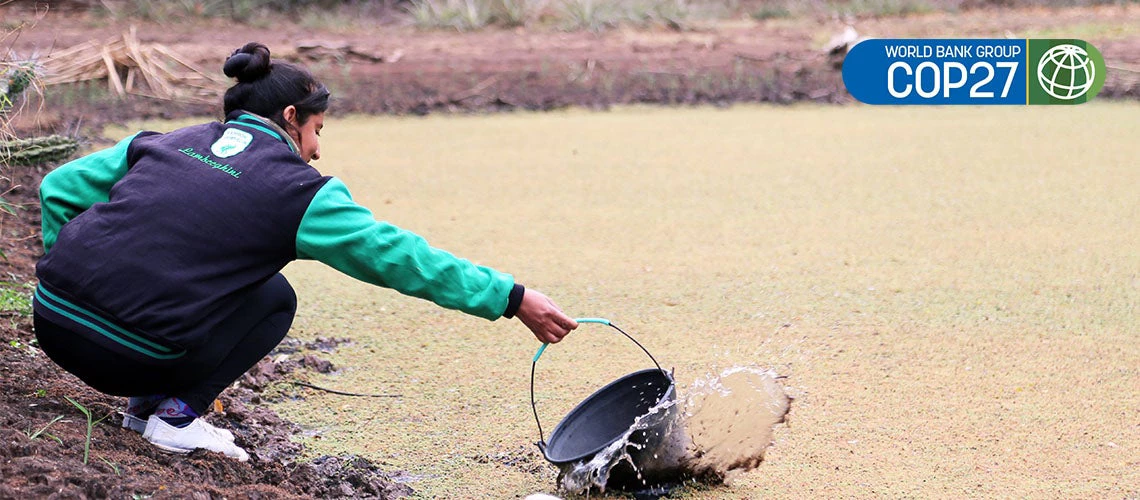 A woman from Norte Grande region in Argentina look for water in a lagoon
A woman from Norte Grande region in Argentina look for water in a lagoon
With about a third of the world’s water resources, Latin America has the highest water endowment per capita, nearly four times the global average. The region’s abundant water resources mean that it boasts the greenest electricity production in the world, with 45% generated by hydropower, and vast agriculture. Latin America is the largest net exporter of food on a regional level, creating jobs for millions of households who depend on agriculture for their livelihoods.
Water is also a critical input for many small and large businesses. It plays a critical role in poverty reduction, accelerating economic growth and sustaining the region’s rich biodiversity. Access to water supply and sanitation services has also led to a significant drop in water-borne diseases over the past three decades and improved living conditions, especially for those in urban areas. In fact, during the recent COVID-19 crisis, sound handwashing practices were a cornerstone of prevention strategies.
Even so, as many as 150 million people or about a quarter of Latin America and the Caribbean´s population live in water-scarce areas and more than 400 million lack safe sanitation. Those numbers are only set to rise as climate change disrupts the water cycle. Andean glaciers have retreated 30 to 50 percent over the past 30 years, threatening the water security of cities and communities. Watersheds are rapidly degrading, and 25 percent of rivers, lakes, and aquifers are polluted due to the discharge of untreated effluents from municipal use, industry, mining, and agriculture.
The most recent droughts that hit the Southern cone of the continent heavily affected the production and quality of crops in Argentina, Chile and Paraguay. Recurrent floods cost about US$1.7 billion in damages every year, while the economic damage from droughts alone over the past 40 years stands at a total of US$24 billion. This is threatening the region’s hard-won socio-economic gains and heightening the risk of social unrest. If no climate action is taken, the situation will only get worse.
The World Bank’s recent report, Why Water Matters: Resilient, Inclusive, and Green Growth in Latin America, makes a powerful case for elevating water to the highest levels of national political agendas. Water should not only be at the heart of efforts to promote inclusion and human development but also climate change adaptation and mitigation policies.
To move forward, the region’s governments, citizens and private actors must look at water as a strategic, finite, and manageable asset, and one that knows no borders.
- Water is a strategic asset. Development of hydraulic infrastructure to manage, store and distribute water better is critical for a sustainable path forward. This means preserving watersheds, safeguarding and expanding both natural and built storage capacity, and boosting investments in rural and poor urban areas to ensure that water reaches every family, every farmer and every industry.
- Water is a finite asset. This places a big premium on more effective and efficient use. Water productivity, irrigation, and soil management are all areas that require attention. Water services - from water and sanitation utilities to irrigation and drainage systems- need to be managed more efficiently to be sustainable, with adequate operation and maintenance and improved financial sustainability for faster service expansion. Households, industries, and service providers are called on to save, stretch and reuse water more systematically.
- Water is a manageable asset. Institutions need to be strengthened by implementing robust water governance systems to manage this asset. Water resource management institutions need to improve their technical autonomy, accountability and transparency. River basin institutions should be empowered, and the capacity of regulatory bodies at all levels must be enhanced. Countries need better information, modeling and planning instruments to safeguard and leverage their water assets and predict and anticipate water risks. To incent asset management, water tenure must be stronger and water risks must be better understood and managed.
- Water knows no borders. Beyond national action, tackling the water crisis will require regional efforts and enhanced partnerships . Higher-level stakeholder coordination, especially for transnational waters in large strategic basins, would be necessary as many of these challenges are of a regional nature. Partnerships with multilateral institutions and regional development agencies would help bolster water security, for example, by enhancing regional information and databases, aligning support to improve governance systems and promoting innovative financing methods bringing public and private actors together with citizens.
The World Bank is already working on these solutions with the region’s governments to strengthen the resilience of the countries and people to climate and water shocks. We help bring stakeholders together, provide targeted financing, and share global experience and innovative approaches that include digitalization, nature-based solutions or circular economy principles. Working together, we can ensure Latin America’s unparalleled water endowment is the asset it should be to realize the vision for a greener, more inclusive, resilient, and sustainable development even in the face of a changing climate.



Join the Conversation